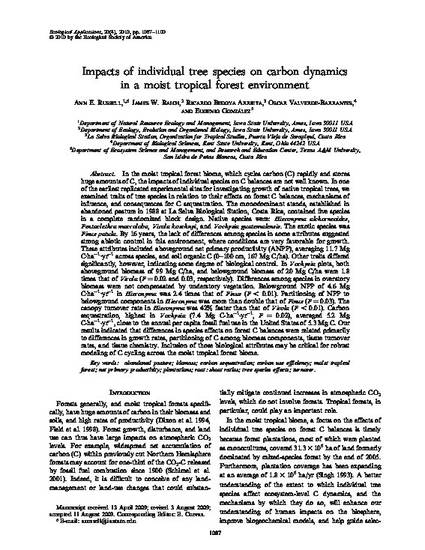
In the moist tropical forest biome, which cycles carbon (C) rapidly and stores huge amounts of C, the impacts of individual species on C balances are not well known. In one of the earliest replicated experimental sites for investigating growth of native tropical trees, we examined traits of tree species in relation to their effects on forest C balances, mechanisms of influence, and consequences for C sequestration. The monodominant stands, established in abandoned pasture in 1988 at La Selva Biological Station, Costa Rica, contained five species in a complete randomized block design. Native species were: Hieronyma alchorneoides, Pentaclethra macroloba, Virola koschnyi, and Vochysia guatemalensis. The exotic species was Pinus patula. By 16 years, the lack of differences among species in some attributes suggested strong abiotic control in this environment, where conditions are very favorable for growth. These attributes included aboveground net primary productivity (ANPP), averaging 11.7 Mg C·ha−1·yr−1 across species, and soil organic C (0–100 cm, 167 Mg C/ha). Other traits differed significantly, however, indicating some degree of biological control. In Vochysia plots, both aboveground biomass of 99 Mg C/ha, and belowground biomass of 20 Mg C/ha were 1.8 times that of Virola (P = 0.02 and 0.03, respectively). Differences among species in overstory biomass were not compensated by understory vegetation. Belowground NPP of 4.6 Mg C·ha−1·yr−1 in Hieronyma was 2.4 times that of Pinus (P < 0.01). Partitioning of NPP to belowground components in Hieronyma was more than double that of Pinus (P = 0.03). The canopy turnover rate in Hieronyma was 42% faster than that of Virola (P < 0.01). Carbon sequestration, highest in Vochysia (7.4 Mg C·ha−1·yr−1, P = 0.02), averaged 5.2 Mg C·ha−1·yr−1, close to the annual per capita fossil fuel use in the United States of 5.3 Mg C. Our results indicated that differences in species effects on forest C balances were related primarily to differences in growth rates, partitioning of C among biomass components, tissue turnover rates, and tissue chemistry. Inclusion of those biological attributes may be critical for robust modeling of C cycling across the moist tropical forest biome.
Available at: http://works.bepress.com/ann_russell/7/

This article is from Ecological Applications 20 (2010): 1087, doi:10.1890/09-0635.1. Posted with permission.